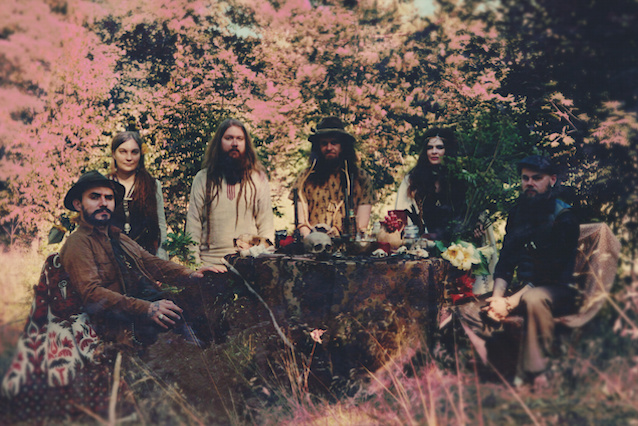In the Rainbow Bar and Grill, you can never tell if it’s night or day. Time doesn’t pass, the patina of dust just gets thicker on the memorabilia-heavy walls. It’s a living time capsule from a time when rock ‘n’ roll ruled the earth.
The Rainbow may not be old in the context of the planet, but it’s ancient in the context of Los Angeles. It’s so old, you wonder how it hasn’t become condo fodder yet. Surrounded by high-rises, it certainly looks not long for this world. When I visited this weekend to attend the bar’s 45th anniversary party, an enormous, foreboding tower crane sat across the street, as if defying it to continue existing.
Videos by VICE
In a city not particularly known for its respect of history, the fact that the building that has housed the Rainbow for 45 years dates back to the late 1920s is remarkable. Originally opened as the Mermaid Club Cafe in the 40s, it became the Villa Nova restaurant—not only did the Villa Nova’s co-owner, Vincente Minnelli, propose to Judy Garland there, Joe DiMaggio and Marilyn Monroe first met in one of its booths.

In 1972, the Villa Nova was sold to nightlife impresarios Elmer Valentine, Lou Adler, and Mario Maglieri, who renamed it the Rainbow in tribute to Garland. Due to its proximity to the Whisky a Go Go and the Roxy, Sunset Strip rock clubs also owned by the trio, it quickly became a haunt of the new Hollywood elite—rock stars like Elton John, Alice Cooper, the Rolling Stones, and Led Zeppelin, the latter of which treated it as its own personal fuck den (“The first time I ever came into the Rainbow,” Motörhead’s Lemmy Kilmister recalled in the book Straight Whisky, “one of Led Zeppelin’s roadies was screwing some chick on the table downstairs.”)
For almost five decades, the Rainbow has unrepentantly been a den of sin and vice. In the 70s, porn stars like John Holmes and Marilyn Chambers and teen groupies like Sable Starr and Lori Mattix were regular patrons. John Belushi ate his last meal, a bowl of lentil soup, at the Rainbow before overdosing at the Chateau Marmont down the street. His autopsy report showed it was the only non-drug substance in his stomach.

In the 80s, the Rainbow became a hair-metal hangout; it is now frozen in and intrinsically linked to this time period. Its only recent addition has been a life-size statue of Lemmy, the bar’s most devoted patron. After his death in 2015, the outdoor patio was christened “Lemmy’s Lounge” in tribute to the man’s undying love of the Rainbow and its video poker machine, which he would play every day when not on tour while consuming an unfathomable number of Jack and Cokes.
Lemmy may be gone, but the Rainbow and hair metal will, in spite of it all, never die. That fact was more than evident at the restaurant’s anniversary celebration, which featured an all-day party in the parking lot with performances by still-kicking metal bands Black ‘n’ Blue, Jetboy, and Quiet Riot. From 2 PM onward, a line of people ranging in age from infant to elderly snaked around the block; upon entrance, they embraced their friends and banged their heads.

As I explored the permanent night of the Rainbow, I realized the 80s had never ended—there, Ronald Reagan was still the president of the United States, a thought I found harrowingly comforting. “We had good times back then!” a middle-aged woman with big hair and bigger tits reminisced to her friend in the bathroom. “We did!” her friend replied. Outside, where it was a bright, cloudless Sunday, the only signs of modernity were ever-encroaching high-rises and tents emblazoned with the Monster Energy Drink logo. A white man in a Deftones shirt shared a joint with a black woman in a Faith No More shirt. Two guys in leather took leave of one another by mutually flashing the devil horns. “You’re gonna want to take a picture of this guy,” a man told me, gesticulating toward another, shyly grinning, man. “He’s Metallica’s original guitarist.” (The man in question, Lloyd Grant, played on the band’s first demo, “Hit the Lights.”) Everyone seemed to know one another—and not only know one another, but like one another.

As the party raged downstairs, The Decline of Western Civilization Part II: The Metal Years, Penelope Spheeris’s legendary documentary about the 80s Sunset Strip music scene, played on tube televisions suspended above the empty dance floor of “Over the Rainbow,” the upstairs bar. Gazing up at the television, I watched as W.A.S.P. guitarist Chris Holmes, floating in a swimming pool, drank himself into a stupor while his mother helplessly looked on. A lot has happened since The Decline of Western Civilization Part II. Most notably, the decline of Western civilization. But Chris Holmes is still alive and has been sober for more than 20 years. Over the Rainbow now houses recovery meetings every weekday at noon.

The Rainbow was—is—a genuine community, a place where the passage of time and the horrors of the outside world can blissfully be avoided. Drinking plastic cups of Jack Daniels in the parking lot under the relentless sun, old timers commiserated like survivors because they were. Not everyone, after all, made it through the 80s. They stood as defiantly as the Rainbow itself, a place its current owner, the son of founder Mario Maglieri, once stated will close “over my dead body.”
Follow Megan Koester on Twitter.




